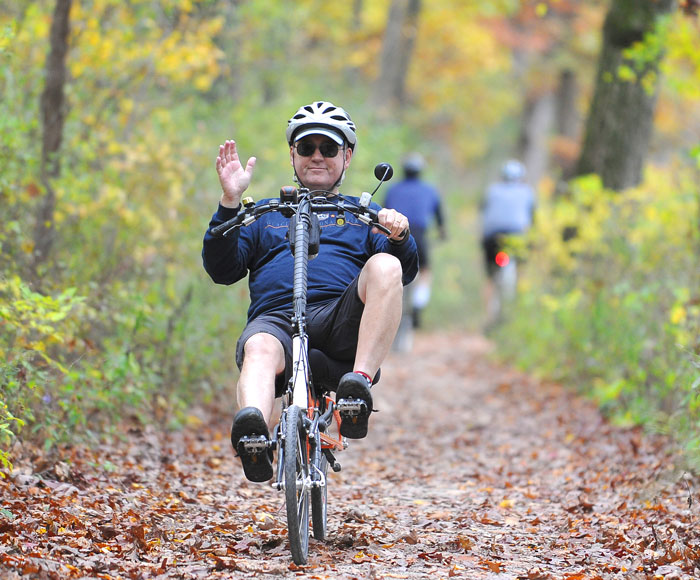Many of us—and our dogs—are lucky to have some type of trail system near our residence. Whether for transportation, exercise or leisure; urban, suburban, rural or backcountry; on foot, bicycle, skis or horse; trails are often the catalyst to get us outside and moving in the first place. And as land becomes more valuable, we’re fortunate that there are organizations and communities that value the importance of trails and are dedicated to developing, protecting and connecting them.
A 2014 study by the American Journal of Public Health showed significant measurable correlation between how close people live to biking and walking infrastructure and the amount of weekly exercise they get, proving that trail access really can lead to healthier communities. The nonprofit American Trails has a mission to “advance the development of diverse, high-quality trails and greenways for the benefit of people and communities.” The website is full of information on planning, enhancing, funding, designing, building and managing trails.
“As a national trails industry alliance, American Trails represents the trails community as a whole. We raise awareness of the value of trails with lawmakers when we advocate for legislation at the federal level that helps fund trails and protects public lands,” said Cathy Corlett, the organization’s director of strategic communication.
The group shares economic data and scientific studies making a case for the value of trails as sustainable transportation and recreation infrastructure, and key to equitable access to public lands. They host regular free webinars for trails professionals and the general public. Their monthly e-newsletter reaches 20,000 subscribers, and more than 4,000 trails-related businesses, organizations and agencies are listed in their business directory.
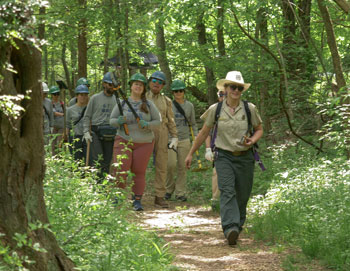
Fortunately, with the increasing popularity of trails, more land developers are seeing a benefit in including outdoor amenities such as trails, according to Corlett. But she pointed out that informal, user-created trails can also proliferate, creating unsafe conditions and damaging sensitive, natural areas. “When new trails are needed, whether on public or private land, a trails master-planning process can help make sure the trails are located and designed in a way that both protects the environment and serves the wider community.”
Corlett described the first step in the planning process as evaluating the existing conditions and considering what types of users will be accommodated. Next, the trail planner makes an accurate plan-view of the site, with any existing trails and other base information such as topography, water bodies, flood plains, property lines, etc. The third step is reaching out to community members for input and hopefully gaining support. Once the planning team has a sense of the physical opportunities and constraints, and an understanding of public desires, they can begin a conceptual trails master plan, which “considers the possible need for trail closures and reclamation, a trail stewardship and maintenance plan, a signage and interpretive plan, a permitting plan, cost estimates for proposed work and professional presentation materials.” A final stage is laying out the proposed trails to refine the design and location and prepare for construction.
The 264-page Kane County (Illinois) Bicycle and Pedestrian Plan contains myriad information on existing and proposed local trails, as well as trail design, maintenance, funding and more. One trail mostly situated in Kane County is the Fox River Trail, which meanders along the Fox River for approximately 40 miles and provides several direct and indirect connections to other regional trails and numerous forest preserve and local trails. It also connects 12 communities along the river, one of which is St. Charles, with a population of about 33,000.
Laura Rudow is superintendent of parks and planning in St. Charles, and she said that based on their observations and patron contact, she believes their trails are well utilized for active transportation, in addition to recreation and exercise. “With the increased usage of e-bikes, using trails as a commuter is a real option for more than half the year.”
And while she pointed out that she has no data to back up economic benefits, the trails certainly get people around. “The ability to ride in from neighboring towns—or locally—to patronize restaurants, breweries, outdoor concerts and festivals is a win-win for all. It reduces parking and traffic congestion and makes those venues accessible for a larger audience.”
Oftentimes, communities will engage residents to assist with trail maintenance duties, helping to provide a sense of ownership among users. Rudow listed some groups in St. Charles that pitch in, including the “St. Charles River Corridor Foundation, the Conservation Foundation, as well as different Earth Day events, scout troops, high school clubs looking for service hours, etc.”
She explained that some sections of local trails are cleared of snow while some are not. Additionally, “Some trails have grant funding tied to them where it may be stipulated that the trails should be left snow covered to provide opportunity for snowshoeing or cross-country skiing and some winter recreation.”
Rudow also mentioned several city and county groups that collaborate “in terms of trails, connectivity and securing grant
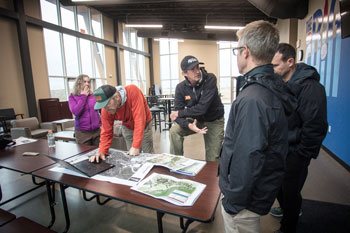
funding to improve existing trails and add more.”
There are trails grants available from many trails organizations as well as government agencies. The Legacy Trails Program grants, funded through the Bipartisan Infrastructure Law, are being administered by American Trails in partnership with the U.S. Forest Service. And the latest round of the U.S. Department of Transportation’s (USDOT) FY23 RAISE Grants were announced, with grants being distributed in 48 states and Washington, D.C., illustrating the significance of creating and connecting walking and biking infrastructure in every region of the country.
The Capital Trails Coalition (CTC), a collaboration of public and private organizations, agencies and volunteers, received a $25 million RAISE grant. CTC was founded by the Rails to Trails Conservancy, the National Park Service and the Washington Area Bicyclist Association (WABA). Kalli Krumpos is the senior organizing manager at WABA, and she explained that the funding will go to Prince George’s and Montgomery counties in Maryland, and Washington, D.C., to “help those entities build out their multi-use trails.”
Many trails organizations and communities stress the need for trails systems to be more equitable, inclusive and accessible, and Krumpos—who stressed that the RAISE grants are an incredibly competitive program—believes that one of the reasons they were awarded the grant is because of the focus on equity in their region. “Every trail project in the application will benefit what USDOT calls ‘areas of persistent poverty’ or historically disadvantaged communities.
“These projects are focused on specific places in our region that have not historically had access to multi-use trails, for transportation or recreation,” continued Krumpos. “As those trails get built out there are continuing benefits.”
She explained that these benefits include everything from environmental impact—as people need to rely less on their cars—to health, to job creation with building and maintaining the trails, to getting better access to other jobs. “This is so important to make sure that the trails we have are truly equitably distributed across our region.”
The International Mountain Biking Association (IMBA) is a national network of local groups, individual riders and volunteers, with a mission “To create, enhance and protect great places to ride mountain bikes.” But, as Eleanor Blick, director of communications for IMBA, points out, these trails benefit everyone, not just mountain bikers. “A successful modern trail system will include a mix of shared-use trails, single-use trails and directional trails so every trail user can have a tailored and enjoyable experience. We also assess existing trail systems for ways to implement these changes, often when a community is experiencing more crowded trails or user conflict.”
IMBA is also involved with mountain bike advocacy. “Our legislative work includes bills that have a broad and positive impact on trails, like recreation packages and funding opportunities,” said Blick. Along with their national policy work, their IMBA Local program “provides support services, education and mentorship programs that help communities accomplish their goals.”
Trail Accelerator grants help IMBA with their goal to get more trails “close to home,” and grant awardees partner with staff to generate a trail plan for their community. “We’ve found a professional trail plan to be a strong tool for trails; it builds community momentum and supports fundraising by shaping a vision for what could be possible,” explained Blick. And for communities that are “trail-curious,” their Trail Labs: Foundations workshops guide attendees on planning and design, construction, activation, promotion and measuring success.
Trail education offerings from IMBA include Trail Care Schools for volunteers and Trail Management Schools for land
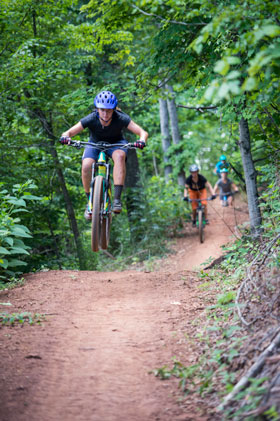
managers. “We plan and promote sustainable trails to minimize impacts on the environment, natural resources and wildlife,” said Blick. “These factors, as well as social sustainability, are incorporated into all our planning, design and construction projects.”
And accessibility is a major focus. “We promote equity and inclusion in mountain biking by working toward more trails close to home to ease entry into the sport.”
Hopkins, Minn., a suburb of Minneapolis, has three regional trails as well as some local trails and biking infrastructure, including the Artery, which was named a Great Street by the American Planning Association. On the two trails that run into Minneapolis, the percentage of transportation use versus recreation use is much higher than on other trails in the 180-mile system, according to Danny McCullough, regional trails system manager at the Three Rivers Park District, the regional parks system that operates Hopkins’ trail system. Though hard to calculate, he said they estimate that more than 25% of use is for transportation, which is much higher than other regional trails in the system. “When we ask trail users if they’re using the trail for transportation or recreation, they most often respond ‘both.’”
Kurt Howard, who’s on the City of Hopkins planning staff, added that the Metropolitan Council (the Twin Cities regional planning agency) makes a distinction between trails that are mostly focused on exercise and recreation versus those that provide connections between regional origins and destinations. “Trails that fit into the latter category are included on what’s called the Regional Bicycle Transportation Network and receive priority when various sources of regional funding are allocated.”
“Hopkins has thought of biking/trails as an economic development tool,” said Howard, who explained that this brings thousands of people through town who can be customers, especially downtown as it’s connected to two regional trails via the Artery. The city has installed a significant amount of bike parking to support bikers as customers, including a shelter, which he pointed out is much cheaper than developing additional auto parking. And with a robust trail system, “housing developers can reduce their auto parking if residents can access jobs and goods by bike, thereby reducing the cost of development and making projects financially feasible.”
A future north/south regional trail is being planned which will connect with other regional trails, and the 20-mile corridor will connect several communities, according to McCullough. Howard said the city is presenting a trail demonstration project to enable community members to try out one of the handful of concepts for a multimodal connection in the corridor that they’ve been studying. “We’ll be hosting an event to kick off the demonstration and hosting pop-up meetings throughout the week that the demonstration will be installed. We’ve also distributed signs, sidewalk decals and posters in the project area to link folks to the project website.”
The goal is to give residents a better sense of what’s being considered beyond just looking at maps and reading plans. Additionally, “the city is able to incorporate feedback received by community members into the eventual design of those multimodal elements and deliver a project that’s more responsive to the community’s needs, wants and interests.”
Howard said that by maintaining and expanding the city’s network of multimodal transportation infrastructure, they aim to increase options for residents who choose not to drive or who are unable to drive. “Providing these community members with safe, comfortable and effective alternatives to driving helps keep Hopkins accessible and inclusive to all segments of society.” Added McCullough, “Our regional trail system provides biking and walking access across the entire Hennepin County region, connecting cities, regional job centers, schools, retail districts and other regional amenities.”
The American Hiking Society (AHS) is a nonprofit organization that envisions “a world where everyone feels welcome in the American hiking community and has permanent access to meaningful hikes, including urban, front country and backcountry opportunities.” They work with Congress, federal agencies and partners on policy issues and legislation to ensure funding for trails and preservation of public lands. They offer hiking resources including gear checklists, trail finding, hiking tips and more. And they oversee many volunteer opportunities, pointing out that “Trails don’t maintain themselves.”
Maggie Peikon is manager of communications for AHS, and she shared some of their volunteer programs, including the Alternative Breaks program for college students and young professionals, and the Volunteer Vacations program where volunteers take on trail stewardship projects in diverse locations across the country, including building, improving and maintaining trails.
Each year, AHS educates and activates on average around 500 volunteers nationally to assist with trail projects,
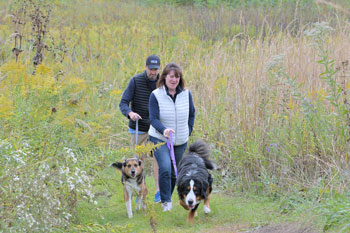
according to Peikon, most of which would not be completed without volunteer support and would add to the mounting backlog of national public land maintenance needs. “These programs give youth and families of all backgrounds access to safe and well-maintained trails, provide communities with outdoor spaces where they can lead active and healthy lifestyles, and provide those underserved in the outdoors with skills, education and opportunities to volunteer in nature for the first time.”
National Trails Day is a nationally coordinated event that occurs on the first Saturday in June, aimed at advocacy and trail service. Hikers, bikers, horseback riders and other outdoor enthusiasts join trails clubs, local and federal agencies, businesses and land trusts to advocate for, maintain and clean up public lands and trails. Peikon said they celebrated their 31st National Trails Day this year with an amazing turnout and incredible impact on trails and natural spaces.
“We had an estimated 799 registered events across the country with over 70,000 participants,” said Peikon. “There were 211 trail service projects that brought out over 7,000 stewardship volunteers. Their collective hard work resulted in 558 miles of trails being improved.”
Additionally, she said that 5,327 people took the National Trails Day Pledge, “committing to leaving the trails and the outdoor community better than they found them.”
Back in Minnesota, McCullough described the Adopt-a-Trail program at Three Rivers Park District, which he called very successful. “We break our entire regional trail system into two-mile segments and offer those to individuals or businesses for sponsorship. So far, over 60% of our trail system has coverage that includes trash removal and some brush removal. The minimum requirement is two cleanup days per year but most volunteer for more than that amount.”
He said many private businesses use this as a team-building effort for their employees. “Additionally, it reduces the amount of time and trips our maintenance staff have to mobilize to collect litter and debris along trail shoulders.”
Trails provide so many positives for communities, and it’s important that we all become stewards and that we work to include everyone in the benefits they offer. “Trails come in many shapes and sizes,” said Corlett, “from urban trails and greenways, bike and mountain bike trails, equestrian trails, off-road trails, to hiking, ski, snow and water trails, so trails managers must be ready to accommodate the full spectrum of humanity enjoying all sorts of outdoor activities. Our vision is a more diverse, equitable and inclusive trails workforce, and a trail within 10 minutes of every American.” RM



